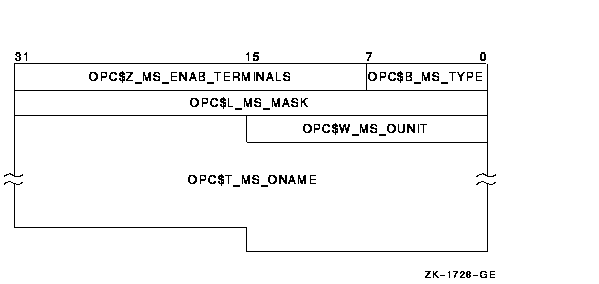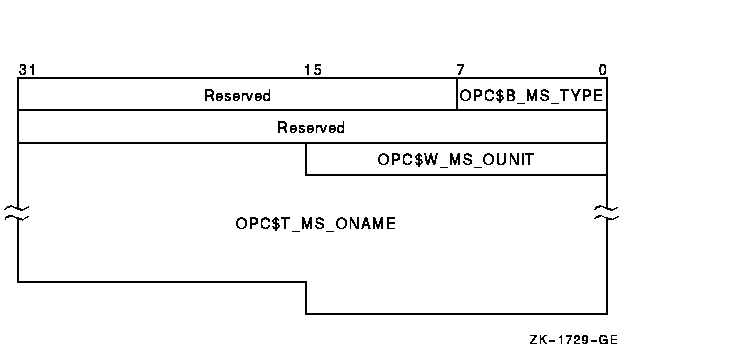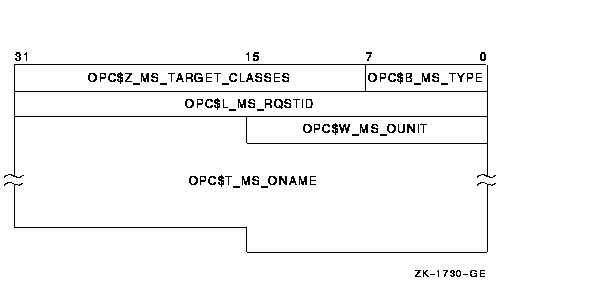 |
HP OpenVMS System Services Reference Manual
Message Buffer Format for OPC$_RQ_CANCEL

|
OPC$B_MS_TYPE
|
This 1-byte field contains the request code OPC$_RQ_CANCEL.
|
|
OPC$Z_MS_TARGET_CLASSES
|
This 3-byte field contains a 24-bit bit vector that specifies which
operator terminal types are to receive the cancellation request. The
$OPCDEF macro defines symbolic names for the operator terminal types.
You construct the bit vector by specifying the desired symbolic names
in a logical OR operation. Following is the symbolic name of each
operator terminal type:
|
OPC$M_NM_CARDS
|
Card device operator
|
|
OPC$M_NM_CENTRL
|
Central operator
|
|
OPC$M_NM_SECURITY
|
Security operator
|
|
OPC$M_NM_CLUSTER
|
OpenVMS Cluster operator
|
|
OPC$M_NM_DEVICE
|
Device status information
|
|
OPC$M_NM_DISKS
|
Disk operator
|
|
OPC$M_NM_NTWORK
|
Network operator
|
|
OPC$M_NM_TAPES
|
Tape operator
|
|
OPC$M_NM_PRINT
|
Printer operator
|
OPC$M_NM_OPER1
through
OPC$M_NM_OPER12
|
System-manager-defined operator functions
|
|
|
OPC$L_MS_RQSTID
|
This longword field contains a user-supplied longword message code.
|
Message Buffer Format for OPC$_RQ_REPLY

|
OPC$B_MS_TYPE
|
This 1-byte field contains the request code OPC$_RQ_REPLY.
|
|
Reserved
|
This 1-byte field is reserved for future use.
|
|
OPC$W_MS_STATUS
|
This 2-byte field contains the low-order word of the longword condition
value that $SNDOPR returns in the mailbox specified by the
chan argument. You can find a list of these longword
condition values under Condition Values Returned in the Mailbox. To
test the completion status, you need to extract the low-order word from
the longword condition value and compare it to the contents of the
OPC$W_MS_STATUS field.
|
|
OPC$L_MS_RPLYID
|
This 4-byte field contains a user-supplied message code.
|
|
OPC$W_MS_OUNIT
|
This 2-byte field contains the unit number of the terminal to which the
operator reply is to be sent. To obtain the unit number of the
terminal, you can call $GETDVI, specifying the DVI$_FULLDEVNAM item
code. The information returned will consist of the node name and device
name as a padded string. Because the unit number is found on the tail
end of the string, you must parse the string. One way to do this is,
starting from the tail end, to search for the first alphabetic
character; the digits to the right of this alphabetic character
constitute the unit number.
After extracting the unit number, count the remaining characters in
the string. Then, construct a counted ASCII string and use this for the
following field, OPC$T_MS_ONAME.
|
|
OPC$T_MS_ONAME
|
This variable-length field contains a counted ASCII string specifying
the device name of the terminal that is to receive the operator reply.
The maximum total length of the string is 14 bytes. See the preceding
field description (OPC$W_MS_OUNIT) to learn how to obtain the device
name.
|
|
OPC$L_MS_OTEXT
|
This variable-length field contains an ASCII string specifying
operator-written text to be sent to the user terminal. The length of
the string must be in the range 0 to 255 bytes. This field is optional.
|
Message Buffer Format for OPC$_RQ_TERME

|
OPC$B_MS_TYPE
|
This 1-byte field contains the request code OPC$_RQ_TERME.
|
|
OPC$Z_MS_ENAB_TERMINALS
|
This 3-byte field contains a user-supplied value. The value 0 indicates
that the specified terminal is to be disabled for the specified
operator classes. Any nonzero value indicates that the specified
terminal is to be enabled for the specified operator classes.
|
|
OPC$B_MS_MASK
|
This 4-byte field contains a 4-byte bit vector that specifies which
operator terminal types are to be enabled or disabled for the specified
terminal. The $OPCDEF macro defines symbolic names for the operator
terminal types. You construct the bit vector by specifying the desired
symbolic names in a logical OR operation. Following is the symbolic
name of each operator terminal type:
|
OPC$M_NM_CARDS
|
Card device operator
|
|
OPC$M_NM_CENTRL
|
Central operator
|
|
OPC$M_NM_SECURITY
|
Security operator
|
|
OPC$M_NM_CLUSTER
|
OpenVMS Cluster operator
|
|
OPC$M_NM_DEVICE
|
Device status information
|
|
OPC$M_NM_DISKS
|
Disk operator
|
|
OPC$M_NM_NTWORK
|
Network operator
|
|
OPC$M_NM_TAPES
|
Tape operator
|
|
OPC$M_NM_PRINT
|
Printer operator
|
OPC$M_NM_OPER1
through
OPC$M_NM_OPER12
|
System-manager-defined operator functions
|
|
|
OPC$W_MS_OUNIT
|
This 2-byte field contains the unit number of the operator terminal to
be enabled or disabled for the specified operator terminal types. To
obtain the unit number of the terminal, you can call $GETDVI,
specifying the DVI$_FULLDEVNAM item code. The information returned will
consist of the node name and device name as a padded string. Because
the unit number is found on the tail end of the string, you must parse
the string. One way to do this is, starting from the tail end, to
search for the first alphabetic character; the digits to the right of
this alphabetic character constitute the unit number.
After extracting the unit number, count the remaining characters in
the string. Then, construct a counted ASCII string and use this for the
following field, OPC$T_MS_ONAME.
|
|
OPC$T_MS_ONAME
|
This variable-length field contains a counted ASCII string specifying
the device name of the operator terminal to be enabled or disabled for
the specified operator terminal types. The maximum total length of the
string is 16 bytes. See the preceding field description
(OPC$W_MS_OUNIT) to learn how to obtain the device name.
|
Message Buffer Format for OPC$_RQ_STATUS

|
OPC$B_MS_TYPE
|
This 1-byte field contains the request code OPC$_RQ_STATUS.
|
|
Reserved
|
This 3-byte field is reserved for future use.
|
|
Reserved
|
This 4-byte field is reserved for future use.
|
|
OPC$W_MS_OUNIT
|
This 2-byte field contains the unit number of the operator terminal
whose status is to be requested. To obtain the unit number of the
terminal, you can call $GETDVI, specifying the DVI$_FULLDEVNAM item
code. The information returned will consist of the node name and device
name as a padded string. Because the unit number is found on the tail
end of the string, you must parse the string. One way to do this is,
starting from the tail end, to search for the first alphabetic
character; the digits to the right of this alphabetic character
constitute the unit number.
After extracting the unit number, count the remaining characters in
the string. Then, construct a counted ASCII string and use this for the
following field, OPC$T_MS_ONAME.
|
|
OPC$T_MS_ONAME
|
This variable-length field contains a counted ASCII string specifying
the device name of the operator terminal whose status is requested. The
maximum total length of the string is 14 bytes. See the preceding field
description (OPC$W_MS_OUNIT) to learn how to obtain the device name.
|
Message Buffer Format for OPC$_RQ_LOGI

|
OPC$B_MS_TYPE
|
This 1-byte field contains the request code OPC$_RQ_LOGI.
|
|
OPC$Z_MS_TARGET_CLASSES
|
This 3-byte field contains a 24-bit bit vector that specifies which
operator terminal types are to receive the cancellation request. The
$OPCDEF macro defines symbolic names for the operator terminal types.
You construct the bit vector by specifying the desired symbolic names
in a logical OR operation. Following is the symbolic name of each
operator terminal type:
|
OPC$M_NM_CARDS
|
Card device operator
|
|
OPC$M_NM_CENTRL
|
Central operator
|
|
OPC$M_NM_SECURITY
|
Security operator
|
|
OPC$M_NM_CLUSTER
|
OpenVMS Cluster operator
|
|
OPC$M_NM_DEVICE
|
Device status information
|
|
OPC$M_NM_DISKS
|
Disk operator
|
|
OPC$M_NM_NTWORK
|
Network operator
|
|
OPC$M_NM_TAPES
|
Tape operator
|
|
OPC$M_NM_PRINT
|
Printer operator
|
OPC$M_NM_OPER1
through
OPC$M_NM_OPER12
|
System-manager-defined operator functions
|
|
|
OPC$L_MS_RQSTID
|
This longword field contains a user-supplied value.
The value 0 specifies that the current operator log file is to be
closed and a new log file opened with all classes enabled
(OPC$B_MS_TARGET is ignored).
The value 1 specifies that the current operator log file is to be
closed but no new log file is to be opened.
The value 2 specifies that the classes in OPC$B_MS_TARGET are added
to the current operator log file classes. A log file is opened if
necessary.
The value 3 specifies that the operator classes in OPCB_MS_TARGET
are to be removed from the operator log file classes. If all classes
are removed, the log file is closed.
|
|
OPC$W_MS_OUNIT
|
This 2-byte field contains the unit number of the operator terminal
that is making the initialization request. To obtain the unit number of
the terminal, you can call $GETDVI, specifying the DVI$_FULLDEVNAM item
code. The information returned will consist of the node name and device
name as a padded string. Because the unit number is found on the tail
end of the string, you must parse the string. One way to do this is,
starting from the tail end, to search for the first alphabetic
character; the digits to the right of this alphabetic character
constitute the unit number.
After extracting the unit number, count the remaining characters in
the string. Then, construct a counted ASCII string and use this for the
following field, OPC$T_MS_ONAME.
|
|
OPC$T_MS_ONAME
|
This variable-length field contains a counted ASCII string specifying
the device name of the operator terminal that is making the
initialization request. The maximum total length of the string is 14
bytes. See the preceding field description (OPC$W_MS_OUNIT) to learn
how to obtain the device name.
|
chan
| OpenVMS usage: |
channel |
| type: |
word (unsigned) |
| access: |
read only |
| mechanism: |
by value |
Channel assigned to the mailbox to which the reply is to be sent. The
chan argument is a longword value containing the
number of the channel. If you do not specify chan or
specify it as the value 0 (the default), no reply is sent.
If a reply from the operator is desired, you must specify the
chan argument.
Description
The $SNDOPR service performs the following functions:
- Sends a user request to operator terminals
- Sends a user cancellation request to operator terminals
- Sends an operator reply to a user terminal
- Enables an operator terminal
- Displays the status of an operator terminal
- Initializes the operator log file
This system service requires system dynamic memory; it cannot be called
from kernel mode.
The general procedure for using this service is as follows:
- Construct the message buffer and place its final length in the
first word of the buffer descriptor.
- Call the $SNDOPR service.
- Check the condition value returned in R0 to make sure the request
was successfully made.
- Issue a read request to the mailbox specified, if any.
- When the read operation completes, check the 2-byte condition value
in the OPC$W_MS_STATUS field to make sure that the operation was
performed successfully.
The format of messages displayed on operator terminals follows:
%%%%%%%%%%% OPCOM dd-mmm-yyyy hh:mm:ss.cc
message specific information
|
The following example shows the message displayed on a terminal as a
result of a request to enable that terminal as an operator terminal:
%%%%%%%%%%% OPCOM 30-DEC-2001 13:44:40.37
Operator _NODE$LTA5: has been enabled, username HOEBLE
|
The following example shows the message displayed on an operator
terminal as a result of a request to display the status of that
operator terminal:
%%%%%%%%%%% OPCOM 30-DEC-2001 12:11:10.48
Operator status for operator _NODE$OPA0:
CENTRAL, PRINTER, TAPES, DISKS, DEVICES, CARDS, CLUSTER, SECURITY,
OPER1, OPER2, OPER3, OPER4, OPER5, OPER6, OPER7, OPER8, OPER9,
OPER10, OPER11, OPER12
|
The following example shows the message displayed on an operator
terminal as a result of a user request:
%%%%%%%%%%% OPCOM 30-DEC-2001 12:57:32.25
Request 1285, from user ROSS on NODE_NAME
Please mount device _NODE$DMA0:
|
Required Access or Privileges
OPER privilege is required for the following functions:
- Enabling a terminal as an operator's terminal
- Replying to or canceling a user's request
- Initializing the operator communication log file
In addition, the operator must have SECURITY privilege to affect
security functions.
Required Quota
None
Related Services
$ALLOC, $ASSIGN, $BRKTHRU, $BRKTHRUW, $CANCEL, $CREMBX, $DALLOC,
$DASSGN, $DELMBX, $DEVICE_SCAN, $DISMOU, $GETDVI, $GETDVIW, $GETMSG,
$GETQUI, $GETQUIW, $INIT_VOL, $MOUNT, $PUTMSG, $QIO, $QIOW, $SNDERR,
$SNDJBC, $SNDJBCW
Condition Values Returned
|
SS$_NORMAL
|
The service completed successfully.
|
|
SS$_ACCVIO
|
The message buffer or buffer descriptor cannot be read by the caller.
|
|
SS$_BADPARAM
|
The specified message has a length of 0 or has more than 986 bytes.
|
|
SS$_DEVNOTMBX
|
The channel specified is not assigned to a mailbox.
|
|
SS$_INSFMEM
|
The service was called from kernel mode or the system dynamic memory is
insufficient for completing the service.
|
|
SS$_IVCHAN
|
You specified an invalid channel number. An invalid channel number is
one that is 0 or a number larger than the number of channels available.
|
|
SS$_MBFULL
|
The mailbox used to support communication is full. Retry at a later
time.
|
|
OPC$_NOPERATOR
|
The service completed successfully; the Operator Communications Manager
(OPCOM) is not running and the message will not be sent. Note that
OPC$_NOPERATOR is a success status and must be tested for explicitly.
|
|
SS$_NOPRIV
|
The process does not have the privilege to reply to or cancel a user's
request; the process does not have read/write access to the specified
mailbox; or the channel was assigned from a more privileged access mode.
|
Condition Values Returned in the Mailbox
|
OPC$_BLANKTAPE
|
The service completed successfully; the operator responded with the DCL
command REPLY/BLANK_TAPE=n.
|
|
OPC$_INITAPE
|
The service completed successfully; the operator responded with the DCL
command REPLY/INITIALIZE_TAPE=n.
|
|
OPC$_NOPERATOR
|
The service completed successfully; no operator terminal was enabled to
receive the message.
|
|
OPC$_RQSTCMPLTE
|
The service completed successfully; the operator completed the request.
|
|
OPC$_RQSTPEND
|
The service completed successfully; the operator will perform the
request when possible.
|
|
OPC$_RQSTABORT
|
The operator could not satisfy the request.
|
|
OPC$_RQSTCAN
|
The caller canceled the request.
|
Examples
| #1 |
#include <ssdef.h>
#include <opcdef.h>
#include <string.h>
#include <descrip.h>
#include <starlet.h>
#include <lib$routines.h>
char input_buffer[256]; /* Input buffer, if needed */
/* VMS descriptors: */
$DESCRIPTOR(input_desc, input_buffer);
$DESCRIPTOR(prompt_desc, "Request> ");
struct dsc$descriptor req_desc;
main(int argc, char *argv[])
{
int status, /* Status of system calls */
length = 0; /* Length of message text */
struct OPC request; /* Request message buffer */
/* Check for too many arguments on command line */
if (argc > 2)
return (SS$_OVRMAXARG);
/* See if request string present on command line... */
if (argc > 1)
{
/* It is. Compute length and copy pointer */
length = strlen(argv[1]);
input_desc.dsc$a_pointer = argv[1];
}
/* If no message present, prompt user for message text */
while (length == 0)
{
status = lib$get_input(&input_desc, &prompt_desc, &length);
if (status != SS$_NORMAL)
return (status);
};
if (length > 128) /* Limit message length */
length = 128; /* to 128 characters */
/* Set up request buffer... */
request.opc$b_ms_type = OPC$_RQ_RQST;
request.opc$b_ms_target = OPC$M_NM_CENTRL;
request.opc$l_ms_rqstid = 0;
memcpy(&request.opc$l_ms_text, input_desc.dsc$a_pointer, length);
/* Set up request buffer descriptor and send message */
req_desc.dsc$w_length = length + 8;
req_desc.dsc$a_pointer = (char *) &request;
return (sys$sndopr(&req_desc, 0));
}
|
This example allows you to build an operator request and send the
request to the operator.
| #2 |
IMPLICIT NONE
! Symbol definitions
INCLUDE '($DVIDEF)'
INCLUDE '($OPCDEF)'
! Structures for SNDOPR
STRUCTURE /MESSAGE/
UNION
MAP
BYTE TYPE,
2 ENABLE(3)
INTEGER*4 MASK
INTEGER*2 OUNIT
CHARACTER*14 ONAME
END MAP
MAP
CHARACTER*24 STRING
END MAP
END UNION
END STRUCTURE
RECORD /MESSAGE/ MSGBUF
! Length of MSGBUF.ONAME
INTEGER*4 ONAME_LEN
! Status and routines
INTEGER*4 STATUS,
2 LIB$GETDVI,
2 SYS$SNDOPR
! Type
MSGBUF.TYPE = OPC$_RQ_TERME
! Enable
MSGBUF.ENABLE(1) = 1
! Operator type
MSGBUF.MASK = OPC$M_NM_OPER1
! Terminal unit number
STATUS = LIB$GETDVI (DVI$_UNIT,
2 ,
2 'SYS$OUTPUT',
2 MSGBUF.OUNIT,,)
IF (.NOT. STATUS) CALL LIB$SIGNAL (%VAL(STATUS))
! Terminal name
STATUS = LIB$GETDVI (DVI$_FULLDEVNAM,
2 ,
2 'SYS$OUTPUT',,
2 MSGBUF.ONAME,
2 ONAME_LEN)
IF (.NOT. STATUS) CALL LIB$SIGNAL (%VAL(STATUS))
! Remove unit number from ONAME and set up counted string
ONAME_LEN = ONAME_LEN - 3
MSGBUF.ONAME(2:ONAME_LEN+1) = MSGBUF.ONAME(1:ONAME_LEN)
MSGBUF.ONAME(1:1) = CHAR(ONAME_LEN)
! Call $SNDOPR
STATUS = SYS$SNDOPR (MSGBUF.STRING,)
IF (.NOT. STATUS) CALL LIB$SIGNAL(%VAL(STATUS))
END
|
This HP Fortran for OpenVMS program enables the current terminal to
receive OPER1 operator messages.
|




